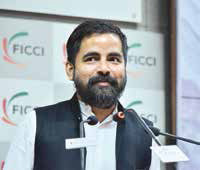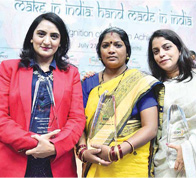
If Corporate India allows more women in its cadre, achieving a double-digit growth shouldn’t be a difficult task, say experts across sections of the society
While an avalanche of accusations by American president-elect Donald Trump for his lewd comments on “prettier and colourful” American women working in its corporate sector brought in a lot of criticism, back home, it’s a different narrative altogether.
And there is a sound logic behind it, as it calls for increased women’s participation at our workplaces to speed up India’s gross domestic product (GDP) growth rate.
Currently hovering around seven percent, India’s GDP can go double digits if only we could enable more and more women to take part in our economy on par with men, asserts Amitabh Kant, CEO of Niti Aayog or the National Institution for Transforming India.
Addressing an impressive gathering of women entrepreneurs recently at Delhi’s FICCI Ladies Organisation (FLO), Kant in his witty and pointed speech said, “Worldwide, women contribute to almost 40 percent to the GDP, while in India it’s just 17 percent. If women’s share in India’s GDP rises to 40 percent, the country would be able to add $700 billion to its GDP by 2025,” he said, citing references of former US President Bill Clinton.

Taking a cue from the stupendous economic growth made by countries like Norway (40.12 percent), Sweden (29.31 percent), Finland (25.89 percent), South Africa (18.31 percent) and the United States (17.37 percent) by having a substantial presence of women in their workforce and board rooms, Kant criticised India’s top corporate leaders for not being fair to the fairer sex in this respect.
He appealed to FICCI’s business leaders to promote more and more women to their middle and senior management level. The current scenario, he added, is “pretty bad” because the presence of women members on boards of Corporate India is less than seven per cent which is “even below the average percentage of many developing countries.”
Nevertheless, he exhorted women achievers, present in big numbers, to exploit their innovative powers as they hold the “key to achieve a double digit growth rate” in the country.
Describing the current economic environment as “extremely conducive for starting a new business”, he said India urgently needed 10 percent growth annually for the next ten years to take care of “its myriad problems.”
It’s important that we learn to respect the country first for making ‘Make in India’ a success because India can never be successful if Indians don’t value Indian products and the importance of being Indian —Sabyasachi Mukherjee
This goal, he said, is “achievable” if only young women entrepreneurs work a bit hard by taking full advantage of various government initiatives taken to raise their contribution to India’s economy.

Author of “Branding India—An Incredible Story” and a key driver of Prime Minister Modi’s flagship initiatives including Make in India, Start-up India and Skill India, Kant said that top business leaders across the world today openly recognise that India is the powerhouse of an “innovative society”.
No wonder that over 1500 multinational companies have set up their global innovation centres in India, he revealed.
The senior bureaucrat who in his earlier avatar had made Kerala a top tourism destination by branding it as “God’s Own Country”, is currently monitoring the progress of the Modi government’s key infrastructure and public-private partnership programs.
Referring to the various measures taken to provide better access to capital, Kant said, “The present government is committed to making `Start-Up India’ and `Make in India’ initiatives an all inclusive and scalable reality and thereby provide an enabling environment for entrepreneurs to thrive in, especially women. Similarly, the new textile policy announced by Smriti Irani, the textile minister, gives lots of boost to exports and generates employment, especially for women,” he added.
But will initiatives like `Make in India’ really succeed?
“It depends,” said India’s top fashion designer Sabyasachi Mukherjee, 42, who also addressed the women entrepreneurs. In his brief but pointed speech, he said, “From modern gadgets to international schooling—today’s millennials are exposed to luxury from day one. The problem with this new generation of Indians is that they have forgotten to celebrate themselves. For every small thing, they wait for validation from the West. I therefore strongly feel an ambitious program like `Make in India’ cannot be successful unless we Indians do not understand the importance of being Indian and buying Indian,” he declared.
A graduate from the National Institute of Fashion Technology Kolkata, who creates ripples during the annual Lakme Fashion Week with his Bollywood clientele, Mukherjee said, “It’s very painful that most Indians have still not come out of their colonial hangover. For a very long time, we’ve been very close to the Western world. We still think that what one gets outside India is the best in the world. This (kind of thinking) needs to change,” he added rather thoughtfully.
India urgently needs a ten percent growth annually for the next ten years to take care of ‘its myriad problems’. This goal is achievable if only young women entrepreneurs work a bit hard by taking full advantage of various government initiatives taken to raise their contribution to India’s economy —Amitabh Kant
The man who designed costumes for Sanjay Leela Bhansali’s award-winning film ‘Black’ which received critical acclaim for its dresses said, “If only we pay as much attention to our social and cultural roots as we pay to our religion, India will be a different country altogether.”

A strong believer in the idea behind ‘Make in India’, Mukherjee described PM Modi “a visionary” who wants to “push the thought of India at the global level.”
Hence, he pleaded, “It’s important that we learn to respect the country first for making ‘Make in India’ a success because India can never be successful if Indians don’t value Indian products and the importance of being Indian.”
Talking about the way people consume fashion nowadays and hinting at the tendency to buy cheap Chinese products, Mukherjee said, “Believe me, the day India starts organising itself, China will be nowhere in the market. It’ll be just a distant cousin,” he added with a twinkle in his eyes.
Concurring wholly with Mukherjee’s nationalistic views, Vinita Bimbhet, President FLO, hoped that after ‘Make in India’, the proposed ‘Handmade in India’ campaign of the Niti Aayog will also help in reviving the country’s rich heritage of hand-woven and handicraft products.
She also felt that if we could leverage the synergy between handlooms, handicrafts, khadi and village industries, there is no reason why India couldn’t play a bigger role in the global markets.
But the million-dollar question is: “Are we prepared to bring about an India-first attitude in our thinking, as Mukherjee suggested earlier?”
By Pradeep Mathur